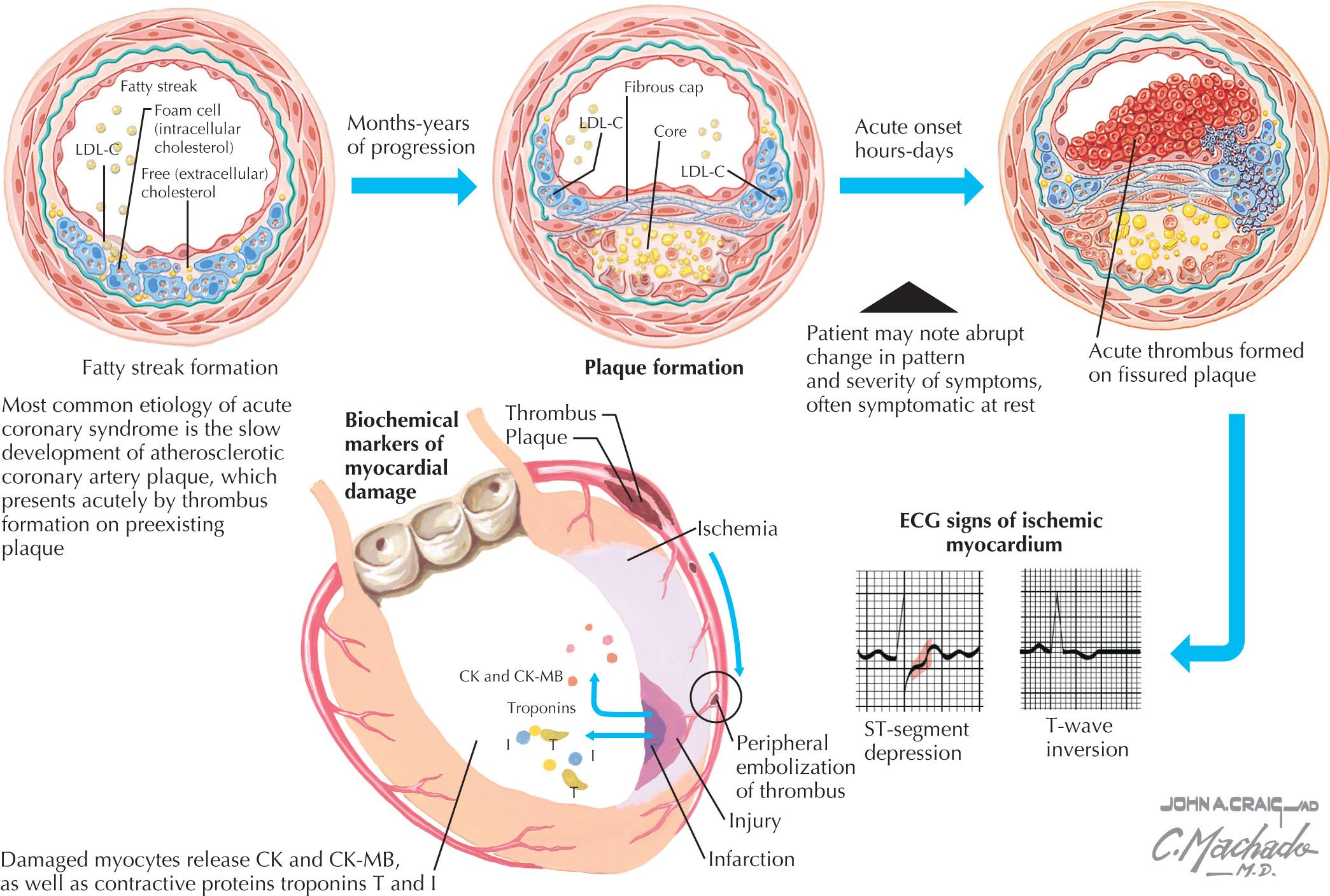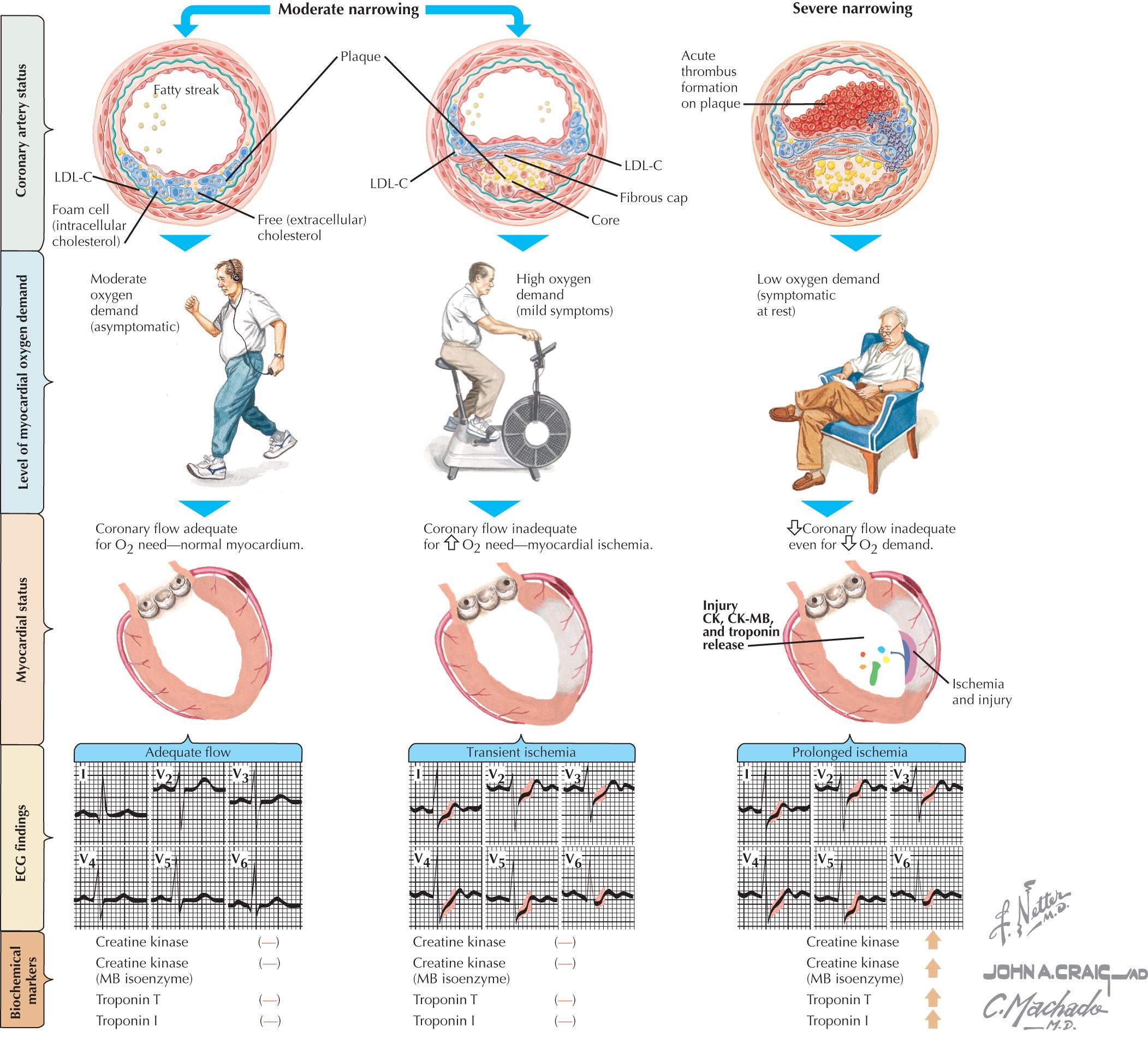Physical Address
304 North Cardinal St.
Dorchester Center, MA 02124
Acute coronary syndrome (ACS) is a term used to describe a group of clinical syndromes included with acute myocardial ischemia. Unstable angina (UA), non–ST-segment elevation myocardial infarction (NSTEMI), and STEMI are included in this group of syndromes. Because the pathophysiology and management of patients with UA and NSTEMI are similar, these two groups are further subclassified as non–ST-segment elevation ACS (NSTE-ACS).
It is estimated that 1.4 million patients present with ACS per year in the United States. The median age of presentation is 68 years of age, and the male-to-female ratio is approximately 3:2. Seventy percent of ACS patients present with NSTE-ACS, and the remaining 30% present with STEMI. This chapter focuses on the diagnosis and management of patients with NSTE-ACS.
The pathogenesis of NSTE-ACS is sudden plaque rupture followed by thrombus formation and partial occlusion of coronary blood flow ( Fig. 20.1 ). These plaques consist of atherosclerotic lesions with lipid-rich cores and a fibrous cap. Previous angiographic studies and recent investigations involving intravascular ultrasound have demonstrated that plaque rupture is more related to the thickness of the fibrous cap than the amount of the lipid-rich core. Atherosclerotic lesions with thin fibrous caps are more prone to plaque rupture than those with thicker caps. Thus, plaque rupture that results in ACS is more likely to occur in lesions with <50% luminal stenosis due to less developed and thinner fibrous caps.

Other less frequent etiologies of ACS include coronary artery spasm secondary to endothelial dysfunction or administration of vasoconstricting agents, spontaneous coronary artery dissection, and thromboembolism.
Common symptoms of NSTE-ACS include sudden onset of retrosternal chest pain with radiation to the neck, jaw, and/or arms. The pain typically occurs at rest or with minimal exertion, and last for ≥10 minutes. For those with previous anginal pain, NSTE-ACS angina may occur with less exertion, greater frequency and/or intensity, and for a longer duration. Associated symptoms include diaphoresis, nausea, and dyspnea. Approximately 30% of patients may present with atypical symptoms, which include fatigue, epigastric discomfort, and pleuritic chest pain.
The clinical manifestations of myocardial ischemia can be mimicked by many other processes. Musculoskeletal disorders involving the cervical spine, shoulder, ribs, and sternum can result in nonspecific chest discomfort and even pain syndromes that are similar to angina pectoris. Symptoms from gastrointestinal causes, including esophageal reflux with associated spasm, peptic ulcer disease, and cholecystitis, are often indistinguishable from angina. Intrathoracic processes such as pneumonia, pleurisy, pulmonary embolism, pneumothorax, aortic dissection, and pericarditis can also produce chest discomfort. Finally, panic attacks and hyperventilation are neuropsychiatric syndromes that can be mistaken for ACS.
NSTE-ACS is an initial clinical diagnosis based on the history obtained from the patient. Typical symptoms include chest pain and/or pressure with radiation to the shoulders, neck, arm, or jaw. The discomfort is usually sudden in onset, occurs at rest, and lasts >10 minutes. Some patients, including women and patients with diabetes, may present with “atypical” symptoms, including nausea, fatigue, emesis, or syncope. A careful evaluation of bleeding risks and history, medical compliance, and upcoming elective procedures is also important in determining if patients are potential candidates for long-term dual antiplatelet therapy.
The physical examination in NSTE-ACS patients focuses on evaluating for signs of hemodynamic instability and heart failure because these findings identify a higher risk group. Signs of heart failure include jugular venous distention, pulmonary congestion (rales), and hypotension. A careful assessment of peripheral pulses is also important for accessing potential access sites in patients in whom an invasive strategy is being considered.
The resting ECG is a key component of the evaluation of patients with suspected ACS and should be performed within 10 minutes of the patient's arrival to the emergency department. Because the initial ECG may be normal in patients with ACS, serial ECGs at 15- to 30-minute intervals should be performed in all patients with suspected ACS. ECG findings consistent with NSTE-ACS include ST depression, T-wave inversion, and transient ST-elevation ( Fig. 20.2 ). It is important to note that a normal ECG does not rule out a diagnosis of ACS and occurs in 5% to 15% of patients who present with ACS.

The biochemical markers of myocardial necrosis, creatine kinase (CK), and its relatively cardiac-specific MB isoenzyme (CK-MB), as well as cardiac troponins T and I, are also essential in the diagnosis and prognosis of patients with ACS. These markers become detectable after myocyte necrosis causes the loss of cell membrane integrity, which eventually allows these intracellular macromolecules to diffuse into the peripheral circulation.
In the past, CK and CK-MB were the primary biochemical markers used to evaluate patients with chest pain. However, several properties of CK and CK-MB limit their predictive value, including their presence at low levels in the blood under normal conditions and their presence in noncardiac sources. Therefore, in most centers, cardiac troponins have become the preferred markers of myocardial necrosis due to their increased sensitivity and specificity for myocardial damage. It should be noted that in chronic renal failure, severe hypertension, and in other less well-understood settings, there are patients in whom troponin concentrations are chronically elevated. It is important to note that an initial normal troponin level does not rule out ACS, and that all patients with a clinical suspicion of ACS need serial biomarker measurements. A rise and fall pattern in cardiac troponin is typically considered to be consistent with ACS.
The four key components of managing patients with NSTE-ACS include (1) risk stratification, (2) selection of overall management strategy, (3) antiplatelet and anticoagulation therapy, and (4) antiischemic therapy.
Because NSTE-ACS can exist in a heterogenous group of patients, proper risk stratification is essential in choosing the appropriate level of management for NSTE-ACS patients. Unstable patients should be considered the highest risk group and includes those with angina refractory to optimal medical management, signs or symptoms of hemodynamic instability, and sustained ventricular tachycardia or fibrillation. More stable patients can be risk stratified based on clinical and laboratory findings.
The Thrombolysis in Myocardial Infarction (TIMI) risk score is a commonly used risk stratification tool and can be easily and quickly implemented in the assessment of NSTE-ACS patients. The score consists of seven 1-point risk indicators based on historical and clinical data evaluated in the Efficacy and Safety of Subcutaneous Enoxaparin in Non–Q-Wave Coronary Events (ESSENCE) and Thrombolysis in Myocardial Infarction 11 (TIMI 11) clinical trials. The seven factors and the associated risk scores are shown in Table 20.1 .
| Risk Factors | Risk of Adverse Cardiac Event a | |
|---|---|---|
| Age >65 | # of risk factors | % risk |
| >3 risk factors for CAD | 0–1 | 4.7 |
| Previous coronary stenosis >50% | 2 | 8.3 |
| >2 anginal event in past 24 h | 3 | 13.2 |
| Aspirin use in past 7 days | 4 | 19.9 |
| ST segment changes | 5 | 26.2 |
| Positive cardiac markers | 6–7 | 41 |
a Myocardial infarction, cardiac-related death, and/or persistent ischemia.
The Global Registry of Acute Coronary Events (GRACE) risk model is another commonly used risk stratification model for NSTE-ACS patients. It is a more complicated model that includes multiple patient variables and findings. Unlike the TIMI risk score, the model cannot be completed at the bedside without the assistance of web-based or smart-phone tools. The web-based application is available at http://www.outcomes-umassmed.org/grace (accessed July 2017).
Once patients are risk-stratified, an overall management strategy should be selected. The four management strategies are discussed in the following sections.
Become a Clinical Tree membership for Full access and enjoy Unlimited articles
If you are a member. Log in here